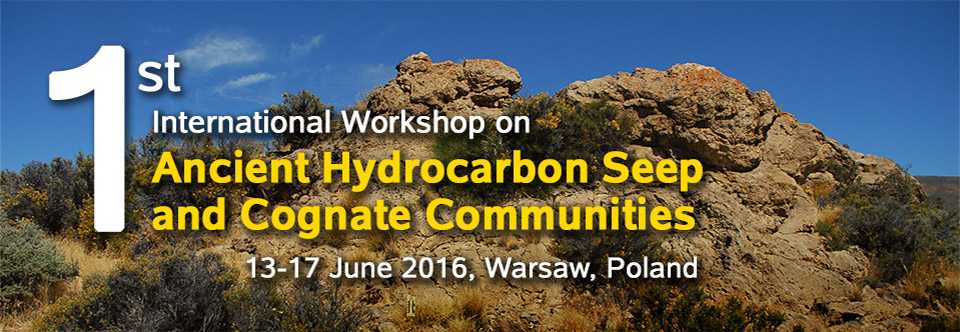
DISTRIBUTION OF MICROBIAL AND INVERTEBRATE FOSSILS ON A PLESIOSAURID CARCASS
Kazuhiro MORIYA1, Robert G. JENKINS2, Andrzej KAIM3, Yoshitsugu KOBAYASHI4, and Hiroki ECHIZENYA4
1Asahi Kohmatsu, Uenosakuragi 1-13-2, Taitou-ku, Tokyo, 110-0002, Japan; 2Kanazawa University, Kakuma-machi, Kanazawa City, 920-1192, Japan; 3Institute of Paleobiology PAS, ul. Twarda 51/55, 00-818 Warszawa, Poland; 4Hokkaido University, Kita 8, Nishi 5, Kita-ku, Sapporo, Hokkaido 060-0808, Japan.
Corresponding author: robertgj@staff.kanazawa-u.ac.jp
Large marine vertebrate falls, e.g., whale carcasses, on the sea floor generate favorable conditions for chemosynthetic communities. In the Cretaceous, prior to the appearance of whales, marine reptile-falls were able to sustain chemosynthesis-based communities (Kaim et al. 2008a). However, no detailed reconstruction of chemosynthetic ecosystems on plesiosaurid carcasses has been undertaken yet. Here we document the distribution patterns of chemosynthetic invertebrate fossils around a plesiosaurid skeleton, as well as micro- and macroborings on plesiosaurid bones. The investigated plesiosaurid occurs in a Cretaceous marine deposit of the Yezo group in Hokkaido, Japan. We observed the surface and a cross section of the specimen. The muddy matrix is still partially preserved, allowing us to observe the boundary between bone surface and sediment. We observed numerous abyssochrysoid gastropods (hokkaidoconchids and provanninds) distributed around the plesiosaurid bones, especially on their upper sides. Several types of borings (e.g. micron-sized filamentous microborings and rounded boreholes with apertures) could be found on the plesiosaurid bones. We hypothesize that the filamentous borings might have been formed by sulfur oxidizing bacteria. The rounded boreholes with apertures within the bones are similar to borings made by modern Osedax. The borings were distributed on the upper side of the bones and a similar pattern was observed for the distribution of abyssochrysoid gastropods, which nowadays are known to graze on bacterial mats. The coincident distribution patterns of abyssochrysoid gastropods and microborings on the plesiosaurid bones indicate that the gastropods grazed on bacterial mats in the Cretaceous times. In addition, bone-eating animals accumulated on the upper side of the bones. These distribution patterns might be influenced by the difference in exposure times between the upper and lower bone surfaces (upper side exposed on the sea floor for a longer time than the lower side due to continuous sedimentation).
References
Kaim, A., Kobayashi, Y., Echizenya, H., Jenkins, R.G., and Tanabe, K. 2008. Chemosynthesis-based associations on Cretaceous plesiosaurid carcasses. Acta Palaeontologica Polonica 53 (1): 97–104.
